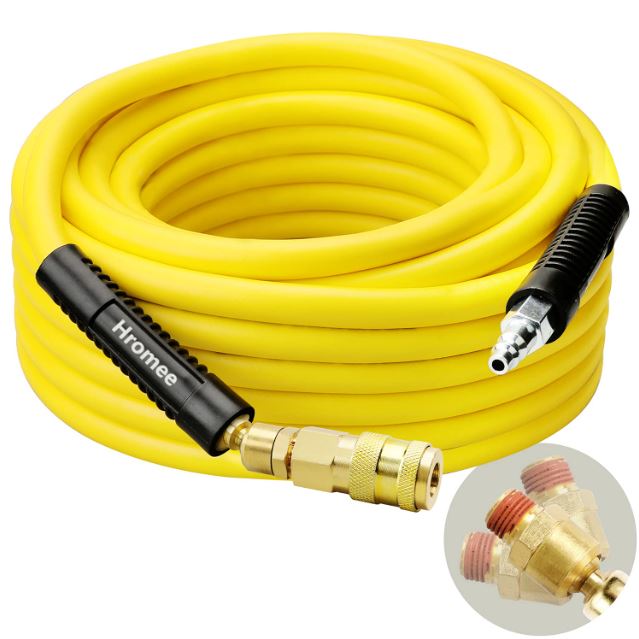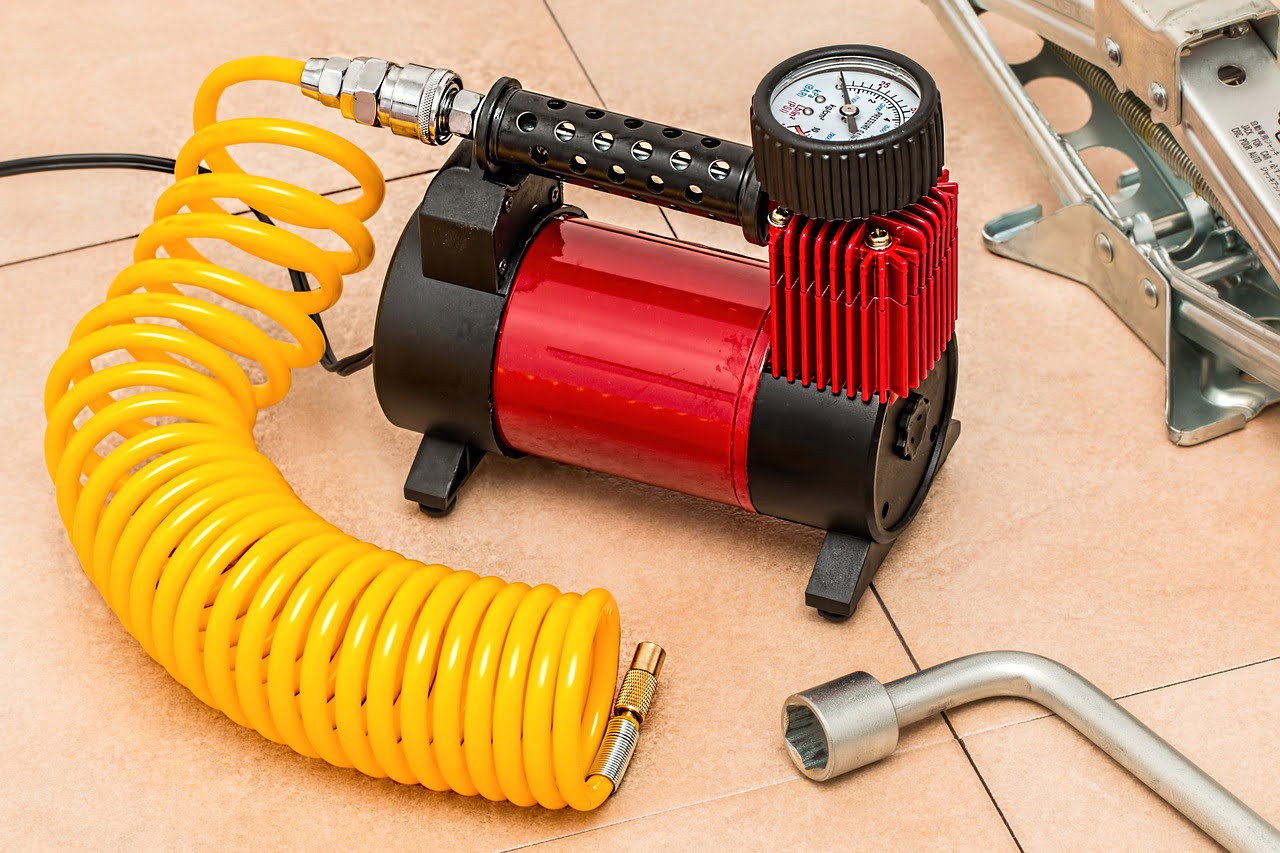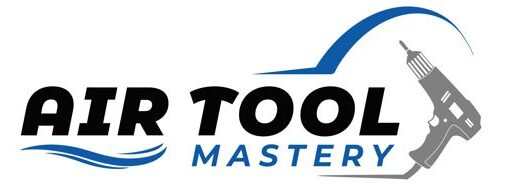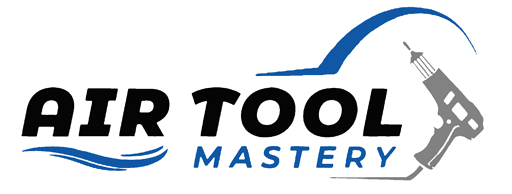The correct choice of the air hoses and fittings determines the further successful operation of the compressor as a whole.
The air hose is required to supply air from the compressor to the connected pneumatic tools:
- impact wrench;
- spray gun;
- airbrush;
- bead gun;
- grinder;
- drill;
- riveter, etc.
Pneumatic fittings are connecting devices used to connect pneumatic hoses to each other and to connect these hoses to pneumatic equipment and tools.
For such systems, reliable sealing is of primary importance; therefore, pneumatic fittings must be of high quality and prevent any air leaks.
It can be a matter of safety as well. So, in this post, we have written some things about air hoses and their fittings that you should definitely know.
Type of air hoses
Of course, like any other item, a compressor hose is categorized by application area and technical parameters. The most common division is into straight and coiled products.
1. Straight hose for organizing a pneumatic line

As a rule, this type of hose has the largest diameter and throughput. It is usually used where high discharge pressure is required. The straight main hose is well-reinforced (strengthened) and has the greatest resistance to temperature changes. Most often, this type of hose is used in industry and production.
2. Curled/Twisted/Spiral hoses

This type of hose is most widely used in all types of automotive services, where pneumatic tools are most often used (tire inflation, drills, etc.).
The peculiarity of the twisted hose is that it is manufactured using a technology that prevents it from straightening out. Even when in a free position, it tends to be twisted into a spiral shape. This feature makes it compact and convenient for storage.
Additionally, the worker does not need to worry about laying out the equipment. Immediately after the end of operation, such a hose is simply twisted into a spiral.
Criteria for selecting air hoses
Any technical product implies certain parameters by which it is selected. In the case of a compressor hose, the parameters are determined by the length, diameter, material of manufacture, type of connection, and pressure that the product can withstand.
1. Length of air hose
One of the important parameters to consider when selecting a product. If the length of the air hose is selected incorrectly, the pressure loss will be proportional.
In some cases, the pressure might not drop significantly enough to attract attention; in others, the drop will be significantly noticeable.
In any case, the parameters for choosing the length of the hose should be taken very seriously. This parameter directly depends on the power of the compressor itself: the higher the power, the longer the sleeve can be.
It is best to select the length depending on the model of a specific compressor. This way, there is a greater likelihood of an optimal ratio of all characteristics.
In the future, when replacing the hose, it is best to simply purchase a section of the same length. It should be noted that the length of the hose should be determined in advance.
If the working length (the length at which the compressor can produce working pressure) is insufficient, you will have to take roundabout ways to do some tasks. Traditional hose sizes are 6, 8, 12, and 15 metres.
2. Diameter of air hose
It is important to choose the right hose diameter. The throughput capacity of the product will depend on this parameter.
Accordingly, the larger the diameter, the more air the compressor can pump in a unit of time. The diameter is extremely important when using a specialized pneumatic tool because there is fairly intensive pumping of air during short breaks.
The larger the diameter of the inner ring of the product, the better suited it is for use in conjunction with a compressor for pneumatic equipment and work with increased pressure. Hoses with a small diameter have lower throughput, therefore, have lower efficiency.
However, in some cases, you may limit yourself to a spiral sleeve of small diameter; the main thing is that it provides the pressure needed for the correct air supply.
It is also important to note the following feature: the thicker the wall of the hose, the greater the impact it can withstand.
The standard diameter of spiral hoses is 6 x 8 mm (internal/external), but you can also find 8 x 10 mm. The latter are less common and are used to solve highly specialized problems. In most cases, you can limit yourself to using the dimensions of the standard sample.
3. Material of the hose
Hoses are made from several basic materials. The material of manufacture will determine not only the price of the product, but also its performance characteristics.
- Plastic. Plastic hoses are considered the lightest of the materials presented. They cope well with low temperatures and rough physical impacts. One of the main recommendations from the manufacturers of such hoses is to use them only in heated rooms. A great option for use in a building or warehouse.
- Rubber. Rubber itself retains its performance properties much longer than any plastic. The main disadvantage of rubber hoses is their weight; they are much heavier than their plastic counterparts, although such hoses are more flexible. However, with prolonged use, the weight of the hose can cause increased fatigue.
- Polyurethane. Polyurethane hose has the optimal ratio of all the main operational properties. It is lightweight, durable, and can withstand cold temperatures and aggressive use. If you plan to use a spiral hose for air, in most cases, it will be better to give preference to polyurethane.
- Reinforced hose: This is a hybrid of rubber and polyurethane. Most often, such a product is reinforced with an additional coating of synthetic threads, which makes the hose more resistant to drops and pinching. Even if you run over such a hose with an inflated tire, it is unlikely to damage it in any way. Unfortunately, the coating significantly increases the weight of an already heavy material. Reinforced hoses are considered the heaviest. Their use is justified where a strong, wear-resistant material is required. Most often, they are used when laying main pneumatic lines. They are also used for compressors and high-pressure devices.
4. Connection type
The type of connection is directly related to the inner diameter of the hose. The most common sizes are 6 mm and 9 mm. These products are sufficient to insert into the compressor and tighten securely with special clamps.
For spiral hoses intended for pneumatic tools, there are screw-in connections on screws of ¼ and 3/8 inches in diameter, respectively. To connect the end of the hose to the device, it is necessary to use the appropriate Euro-type quick coupling. Such a coupling, once inserted, greatly simplifies all subsequent connections to the compressor. This is very convenient when there is only one machine or compressor, and several tools are connected to it one after the other.
Fittings are also used to unify and combine hoses of different diameters into a single air line. These are special tools for branching, used when laying the line and its turns. For quickly switching between tools, quick-change connections are used, the so-called “quick-release” ones:
- bayonet type connection.
- connection with air seal.
5. Working pressure
The last parameter is also the most important. If the pressure in the hose does not meet the requirements, the material of the product will be destroyed quite quickly. In the most worn parts of the hose, a rupture may occur, which, when working with pressure, leads to unwanted “pops”, not to mention other, even less pleasant consequences.
Some hoses operate at pressures up to ten atmospheres (high-pressure hoses), but this is excessive. The most common working pressure is 6–8 bar. The oxygen auto compressor regulator can be set to the maximum, given that the product is prepared to work with such parameters.
There is a situation when the pressure needs to be increased, but the parameter cannot be increased any further, and the handle is in the extreme position. In this case, all the pressure goes into the hose of the unit or compressor. Therefore, when choosing a product, it is extremely important to focus on this parameter. Without taking into account the load, proper operation of the hose under pressure is impossible.
All hoses, without exception, have a certain safety margin. Most often, this indicator fluctuates between 2.5:1 and 4:1. However, it is worth noting that increased load has a negative impact on the strength characteristics of any product, especially those operating under pressure.
The easiest way to set the working pressure is with a car compressor that has a pressure gauge, since the latter allows you to monitor the pressure parameters in real time. If the machine or compressor does not have a pressure gauge, it is best to research the pressure parameters before buying to ensure safe operation.
The operational scope of pneumatic fittings

Pneumatic tubes and pneumatic fittings are used to create reliable connections in pneumatic systems. These systems can be varied and used for different purposes. Also, it is worth noting that these connecting elements are also used in structures that pump previously filtered air.
They are also used when connecting individual elements of a water supply system. This application is justified when it is necessary to install a connection with maximum sealing indicators.
In the case of installing a pneumatic connection device in a water supply system, it is necessary to correctly select the material for making such a fitting. This is necessary to ensure a long service life for both the fitting and the water supply system as a whole.
Pneumatic fittings used in systems transporting filtered air can withstand internal pressures of up to 12 bar. The temperature resistance of these devices ranges from -10 to +70 °C. Acetal high-tech plastic, which has excellent technical characteristics, is used as the material for these pneumatic fittings.
Pneumatic fittings, made of polymers, are used in various industrial fields. In production, they are used to connect elements of systems that transport and process compressed air or other gases.
Let’s consider the main devices that use such connecting elements:
- pneumatic valves and cylinders;
- regulators;
- filters and microfilters.
Types of pneumatic fittings
There are two types of these devices according to their purpose:
- Pneumatic fittings that control the flow of the working medium (compressed air or other gas). Such fittings are capable of changing the physical characteristics of the working medium passing through them. They are used in various systems (for example, a muffler).
- Collet quick-release fittings that are necessary for quick connection or dismantling of individual system elements.
According to their design, all pneumatic connecting fittings are divided into:
Straight pneumatic fittings. Such parts are used to connect two pipes with the same diameter. The connection occurs on a straight section of the structure;
Corner fittings. Used to change the direction of the structure at a certain angle;
Tees. Necessary to organize a branch from the main flow;transition pneumatic fittings. Connect pipes with different diameters;
Connectors. These elements are used to connect pipes with the same or different cross-sectional dimensions, as well as pipes made of different materials;
Plugs. Used to seal the end opening in the system.
The installation of such connecting elements is usually carried out manually. This is necessary in order not to damage the product.
Combining Air Hoses and Fittings
The importance of compatibility between hoses and fittings cannot be overstated. A mismatch between the two can result in several issues, including air leaks, pressure loss, and damage to your tools and equipment. Therefore, always ensure that you check the specifications of both your hose and fittings before making a purchase or attempting to connect the two.
Step-by-Step Guide to Connecting Hoses and Fittings
- Identify the type of fittings: Begin by determining if you have quick-connect fittings or threaded connections.
- Prepare for connection: If you have quick-connect fittings, simply ensure the male end is ready to be inserted into the female end. For threaded connections, prepare your wrenches or pliers for tightening.
- Connect the fittings: For quick-connect fittings, insert the male end into the female end until you hear a click. For threaded connections, manually screw the male end into the female end using your tools.
- Check the connection: Once connected, ensure that the connection is secure and there are no leaks.
Common Issues and Solutions
- Air Leaks: Air leaks are typically caused by a loose connection or a damaged hose or fitting. Ensure that all connections are secure and inspect your equipment for any signs of damage.
- Pressure Loss: This issue could be due to an air leak or a blockage in your hose. Check for leaks and ensure your hose is free of any blockages.
- Equipment Damage: Damage to your tools or equipment may occur due to excessive pressure or incompatible fittings. Always ensure compatibility and the correct pressure settings before use.
Conclusion
Air hoses are essential tools for any workshop or garage. Proper care should be taken when connecting hoses and fittings to ensure safe and efficient operation. Care will help you avoid common issues such as air leaks and pressure loss, ultimately prolonging your equipment’s life.
When choosing your fittings, be sure to consider factors such as compatibility and pressure ratings. When connecting them, follow the steps outlined in this guide for a successful and secure connection. By taking the time to properly connect your air hoses, you can avoid potential safety hazards and costly repairs in the future.
Remember, it’s better to be safe than sorry when working with pressurized air. Keep these tips in mind, and happy connecting! So, always make sure to regularly inspect your hoses and fittings for any signs of damage and replace them as needed. With proper care and maintenance, your air hoses will continue to serve you well for all your pneumatic needs.

